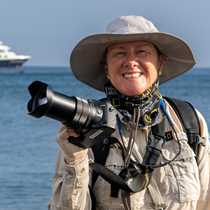Isabela and Fernandina Islands
Punta Vicenta Roca! It evokes incredible images in my mind, and hopefully in other minds as well after today.
Minutes after I woke the early birds from sleep, three (or maybe more?) Bryde’s whales broke the surface of the smooth ocean near the coast off northern Isabela Island. We circled, and despite several turns and approaches, we were never one hundred percent sure they were Bryde’s whales, but it seemed most likely because of their erratic behavior and direction changes. Later hundreds of common dolphins leaped high in front of the ship as we traveled west towards the “nose of the sea horse,” a convenient analogy we use to describe our position off the island that looks so much like a seahorse on the map. Although King Neptune didn’t appear in person, his dolphins were the perfect emissaries for our crossing, appropriate for our purposes, focused as we were on marine life in this area.
Zodiac tours had us guessing about the ocean sunfish, as only brief looks at dorsal fins were visible, but flightless cormorants were in abundance (relatively speaking for Galápagos), sea lions played close to the Zodiacs, and the water looked perfect for snorkeling…calm and clear.
And so it proved, as kayakers floated serenely above sea turtles, the snorkelers saw them first hand, braving the cooler waters of the west with wetsuits on. It was SO thrilling, what can I say. Give me an excuse, and I’ll be in the water and the temperature doesn’t matter. There is just too much to see. As we cruised over rocks and seaweed flowing back and forth with the tidal surges, the turtles grazed or floated beneath us, next to us. Sea lions taunted us, fur seals buzzed us, and for a very few diehards at the end, an ocean sunfish breached and disappeared quickly.
The afternoon on Fernandina Island brought the origins of Galápagos to the forefront, as large marine iguanas marched en masse into the low-tide shallows near sunset to forage before the light completely left the sky.
Punta Vicenta Roca! It evokes incredible images in my mind, and hopefully in other minds as well after today.
Minutes after I woke the early birds from sleep, three (or maybe more?) Bryde’s whales broke the surface of the smooth ocean near the coast off northern Isabela Island. We circled, and despite several turns and approaches, we were never one hundred percent sure they were Bryde’s whales, but it seemed most likely because of their erratic behavior and direction changes. Later hundreds of common dolphins leaped high in front of the ship as we traveled west towards the “nose of the sea horse,” a convenient analogy we use to describe our position off the island that looks so much like a seahorse on the map. Although King Neptune didn’t appear in person, his dolphins were the perfect emissaries for our crossing, appropriate for our purposes, focused as we were on marine life in this area.
Zodiac tours had us guessing about the ocean sunfish, as only brief looks at dorsal fins were visible, but flightless cormorants were in abundance (relatively speaking for Galápagos), sea lions played close to the Zodiacs, and the water looked perfect for snorkeling…calm and clear.
And so it proved, as kayakers floated serenely above sea turtles, the snorkelers saw them first hand, braving the cooler waters of the west with wetsuits on. It was SO thrilling, what can I say. Give me an excuse, and I’ll be in the water and the temperature doesn’t matter. There is just too much to see. As we cruised over rocks and seaweed flowing back and forth with the tidal surges, the turtles grazed or floated beneath us, next to us. Sea lions taunted us, fur seals buzzed us, and for a very few diehards at the end, an ocean sunfish breached and disappeared quickly.
The afternoon on Fernandina Island brought the origins of Galápagos to the forefront, as large marine iguanas marched en masse into the low-tide shallows near sunset to forage before the light completely left the sky.




